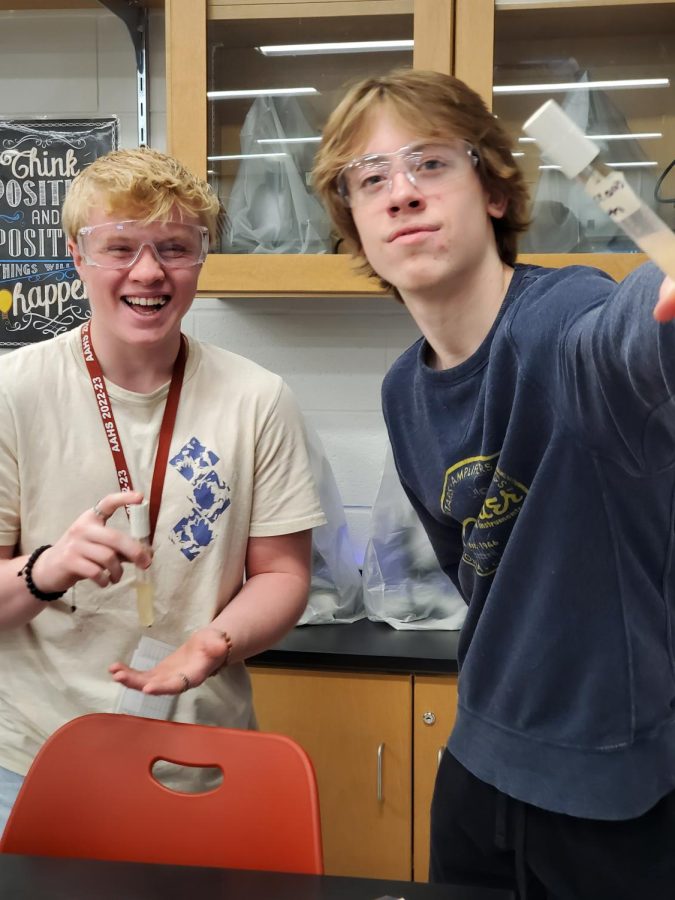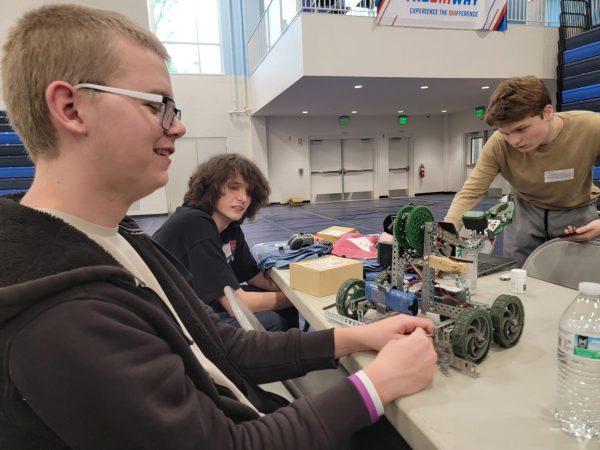Microbiology class swabs school for bacteria
Senior Eli Steward strikes a pose with the bacteria and catches Eli Peteuil off guard.
At the beginning of January, Megan Kutruff and her microbiology class conducted a lab where groups of students went to three different locations around the school and swabbed the area to later find out how much bacteria grows there. After swabbing, the swabs were placed in an incubator for two days to allow the bacteria to grow. According to students, the results were shocking.
“Our group swabbed the boys’ and girls’ bathrooms and the outside door. However, the girls’ bathroom plate got stepped on by a group member, and we had to get a new plate. We swabbed Maddie Miller’s glasses, and her glasses grew more bacteria than the bathroom doors. I did not expect that much bacteria to be on glasses,” senior Eli Peteuil said.
The plate that had grown the most bacteria was Steininger’s turtle. Coming in second was Rebecca Skebeck’s keyboard. However the bathrooms, water fountains and other popular areas grew minimal bacteria, while the wrestling mat grew no bacteria at all.
“My personal favorite part was seeing the excitement from the kids and seeing them think critically about where they should go. I’ve seen some pretty creative things and locations. Mr. Steininger’s turtle was a good one,” Kutruff said.
Kutruff has been performing this lab for the two years she has worked in the high school. She was inspired by a teacher she had ten years ago who also performed the same lab. She likes how the lab is set up, and the only thing she will be changing for next year is placing restrictions on where the groups go to assure not all of the groups swab the same places.
“It was a lot of fun to go out and swab different things around the school. We had a plate be destroyed because someone may or may not have stepped on it, but it’s okay because it was definitely funny. The only thing I would change is not to set the plates on the ground. However, it is a learning experience,” Peteuil said.
The day before the lab, students poured their plates, so they could put their swabs on them. They were also given sterile cotton swabs and a “germ hunting pass” before setting out to obtain their swabs.
“They were allowed to choose whatever sites they wanted to visit around the school as long as they knew the teachers who they were visiting, and they didn’t have a class at that time. Obviously, they couldn’t go to restricted areas without special permission. Once at that site, students took their swabs, and they swabbed the area of interest. When they put the swab on the plate, they put it on in three different directions. They went horizontal, vertical and diagonal across the plate to get full coverage and try to get anything that could have been on that swab onto that plate. Afterwards, they closed the plate and went onto their next site,” Kutruff said.
Throughout the lab, Kutruff asked herself questions about the students and where they were going to swab. However, her main focus was letting the students enjoy the lab and the technique.
“I would say my thought process was, ‘Where are the students going to swab?’ A lot of them I kind of tease where they were going beforehand. Some of them knew where they were going, and others were still thinking. During the lab, I had a couple groups who had to come back for a plate, which is fine,”Kutruff said.
Seniors talked about what they found to be the most interesting information they found out in this lab, along with their favorite parts.
“I think the most interesting thing I’ve learned is how to swab plates. I thought it was more simple then what it actually is, but you have to be really delicate with it. My mom works in a lab, and she makes it look so easy. You have to be careful or you can rip it, and then you would have to start over,” Peteuli said.
“The most interesting thing was actually getting to see the bacteria grow and knowing how it works. You can’t see bacteria with your eyes, but you can see it on the plates,” senior Kristel Basile said.
Peteuil admits to being shocked about the amount of bacteria that grew in the school.
“I am kind of happy with how the results were because while there was still growth, as expected, it wasn’t disgusting, like I was expecting. It wasn’t great, but it wasn’t horrible either. Mrs. Kutruff swapped her phone, but her plate didn’t grow, so I’m glad because I don’t want to know what’s going on on my phone. I’m okay living without knowing,” Peteuil said.

Hi I'm Abigail, but you can call me Abby. This is my third year writing for the newspaper as well as my second year being on the Mountain Echo Newspaper...







